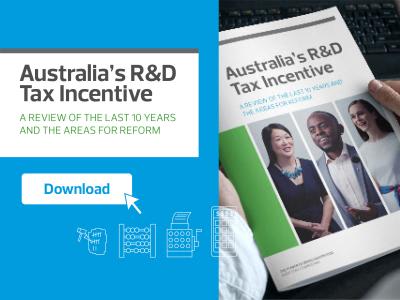Accessing the R&D Tax Incentive in Sydney
Are you an entrepreneur or business owner that strives for innovation through Research & Development?
Research and development (R&D) is a critical step in innovation, and the R&D Tax Incentive is a significant driver of innovation in Australia. The Australian Government is investing in research and development by encouraging companies to undertake R&D activities they might not otherwise be able to fund.
R&D can be an risky and expensive undertaking, particularly for small businesses and entrepreneurs who may have limited resources and financial support.
The Research and Development (R&D) Tax Incentive (RDTI), is a government-assistance program that can give your Australian business up to 43.5% cash back to help mitigate some of this risk and cost.
Many companies are unaware of the R&D incentive and the financial benefits it provides. Others simply do not have the in-house capabilities to make a claim.
This is where the Sydney R&D tax specialists at RSM can assist.

DID YOU KNOW?
The size of the R&D offset is determined by the entity's aggregated turnover.
UNDER $20 MILLION AGGREGATED TURNOVER
Entitles the entity to a refundable R&D tax offset calculated as tax rate + 18.5%. This equals 43.5% for companies on a 25% corporate tax rate. This means profitable entities pay less tax and entities making a loss will get a cash refund.
OVER $20 MILLION AGGREGATED TURNOVER
Entitles the entity to a non-refundable R&D tax offset that can reduce its tax liability or be carried forward to future periods. Depending on your ‘R&D intensity’, the incremental R&D benefit range from 8.5% to 16.5%.

R&D tax incentive FAQ's:
Our tax advisers can help you has extensive experience in successfully preparing applications and obtaining R&D benefits for activities undertaken to acquire new knowledge; or information in relation to new or improved materials, products, devices, processes or services.
Here is a few commonly asked questions to get you started:
If you are conducting R&D activities, you may be eligible to claim an R&D tax offset under the R&D tax incentive.
The R&D Tax Incentive is broad-based support across all industries, provided the relevant R&D eligibility criteria is met.
Some common industries that we see claiming the R&D incentive include Biotechnology, Technology / Software, Mining, Engineering, Manufacturing and Life Sciences.
You should assess whether you, and the activities you are conducting, qualify for a claim under the R&D tax incentive. To help you do this, we have set out the 6 steps you need to take to work out if you can claim and, if so, how much.
Some common industries that we see claiming the R&D incentive include Biotechnology, Technology / Software, Mining, Engineering, and Life Sciences.
The tax offset for eligible R&D conducted from 1 July 2021 is now based on a premium on top of your corporate tax rate.
Turnover of less than $20 million
For R&D entities with aggregated turnover of less than $20 million, the refundable R&D tax offset is your corporate tax rate plus an 18.5% premium.
Turnover of $20 million or more
For R&D entities with aggregated turnover of $20 million or more, the non-refundable R&D tax offset is your corporate tax rate plus an incremental premium.
The premium increments are based on your R&D Intensity. This is a percentage of your eligible R&D expenditure as proportion of your total expenditure for the year.
All eligible R&D expenditure up to 2% R&D intensity will receive a non-refundable R&D tax offset equal to your corporate tax rate plus 8.5% premium.
Additional eligible R&D expenditure above 2% R&D intensity will receive a non-refundable R&D tax offset of your corporate tax rate plus 16.5% premium.
Each R&D activity will have of one or more step that you must complete to achieve an activity outcome.
The program supports R&D activities that can be shown to meet specific legislative criteria. These activities must meet the requirements set out in the definitions of an eligible core or supporting R&D activity.
The definition of an eligible R&D activity under the R&DTI
Eligible R&D activities are defined in the legislation that underpins the program. Division 355 of the Income Tax Assessment Act 1997 identifies eligible activities as either core R&D activities or supporting R&D activities.
Core R&D activities
Core R&D activities are experimental activities:
- Whose outcome cannot be known or determined in advance on the basis of current knowledge, information or experience, but can only be determined by applying a systematic progression of work that:
- is based on principles of established science; and
- proceeds from hypothesis to experiment, observation and evaluation, and leads to logical conclusions; and
- That are conducted for the purpose of generating new knowledge (including new knowledge in the form of new or improved materials, products, devices, processes or services).
Supporting R&D activities
Supporting R&D activities are activities directly related to* core R&D activities.
The tax offset for eligible R&D conducted from 1 July 2021 is now based on a premium on top of your corporate tax rate. The R&D tax credit is between 18.5% to 43.5%, depending on your turnover as outlined below.
Therefore, if you were to spend $100,000 on developing a new product, you could get back between $18,500 and $43,500 depending on the company revenue and profitability.
Aggregated turnover of less than $20 million
For R&D entities with aggregated turnover of less than $20 million, the refundable R&D tax offset is your corporate tax rate plus an 18.5% premium.
Aggregated turnover of $20 million or more
For R&D entities with aggregated turnover of $20 million or more, the non-refundable R&D tax offset is your corporate tax rate plus an incremental premium.
The premium increments are based on your R&D Intensity. This is a percentage of your eligible R&D expenditure as proportion of your total expenditure for the year.
All eligible R&D expenditure up to 2% R&D Intensity will receive a non-refundable R&D tax offset equal to your corporate tax rate plus 8.5% premium.
Additional eligible R&D expenditure above 2% R&D Intensity will receive a non-refundable R&D tax offset of your corporate tax rate plus 16.5% premium.
If a business is conducting at least one core R&D activity during the year and satisfies the above eligibility criteria, then the next step is to calculate the expenditure attributable to the core and supporting R&D activities conducted.
Eligible R&D expenditure may include:
- Employee salary and wages
- Labour on-costs such as superannuation, workers compensation and payroll tax
- Contractor expenses
- Depreciation of plant and equipment
- Expenditure to research service providers and co-operative research centres
- Overhead expenses including rent, electricity, telephone and internet
- Travelling expenses from attending technical conferences or on-site testing
The R&D Tax Incentive is collaboratively managed by AusIndustry and the Australian Taxation Office. Upon the conclusion of the company's fiscal year, an R&D application is lodged with AusIndustry, outlining both the primary and supplementary R&D endeavors undertaken during that fiscal year.
The application must be submitted within 10 months of the end of the company’s income year, so for companies with a 30 June year-end, the deadline is 30 April of the following year.
After AusIndustry completes the processing of the application, a unique registration number is issued for inclusion in the company's income tax return. When the tax return is filed, the Australian Taxation Office (ATO) facilitates the R&D tax offset to reduce the company's income tax obligation, which may result in a tax refund for the company.
GET IN TOUCH
Get in touch with a Research and Development Tax Incentive expert
MEET THE SYDNEY R&D TAX TEAM
Jessica Olivier

Jessica Olivier is the National Leader, Manufacturing and a Director of the Tax Services division in Sydney, providing specialist R&D tax incentive compliance and consulting services.
Introducing Jess, an accomplished and experienced R&D professional providing R&D tax incentive compliance and advisory services. Drawing from a diverse background, she specialises in all aspects of the R&D claim process including delivering insightful presentations to help educate and evaluate R&D eligibility, identifying potential R&D projects and activities through workshops as well as assistance with documentation requirements. The RSM team can also provide a free “health check” reviewing previous R&D claims for accuracy as well as supporting your current R&D process by preparing critical R&D registration documents, identifying R&D costs and calculating eligible R&D expenditure. Jess can also advise on the implementation of robust R&D management strategies and delivers unwavering support during AusIndustry/ATO review if/as required. Get in touch with Jess >>
Peter Xi

Peter Xi serves as a Director in the Tax Division at the Sydney office, specialising in R&D tax incentive compliance services.
Peter facilitates access to innovation funding via the R&D Tax Incentive program, encompassing Advanced/Overseas Findings and R&D debt financing through partnerships with RSM's finance associates. He provides guidance and support for reviews and audits of companies' R&D Tax Incentive claims conducted by AusIndustry or the ATO. Peter also conducts thorough assessments of past R&D claims to validate the legitimacy of claimed benefits, even during due diligence processes, and additionally, offers advice on R&D management practices, optimal governance procedures, intricate matters involving R&D Tax Incentive integrity rules, and scenarios where R&D Tax legislation intersects with other Tax Acts. Get in touch with Peter >>











